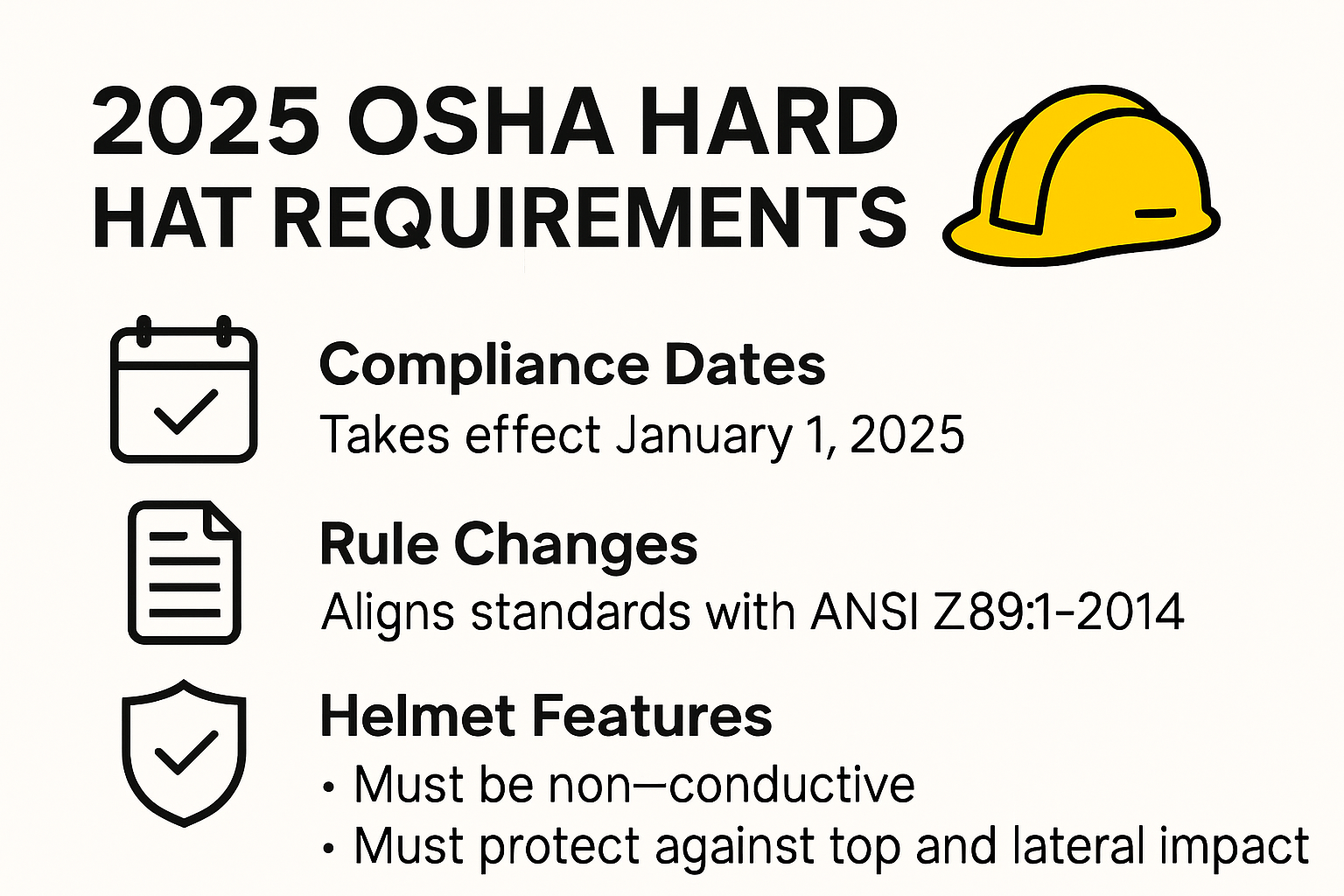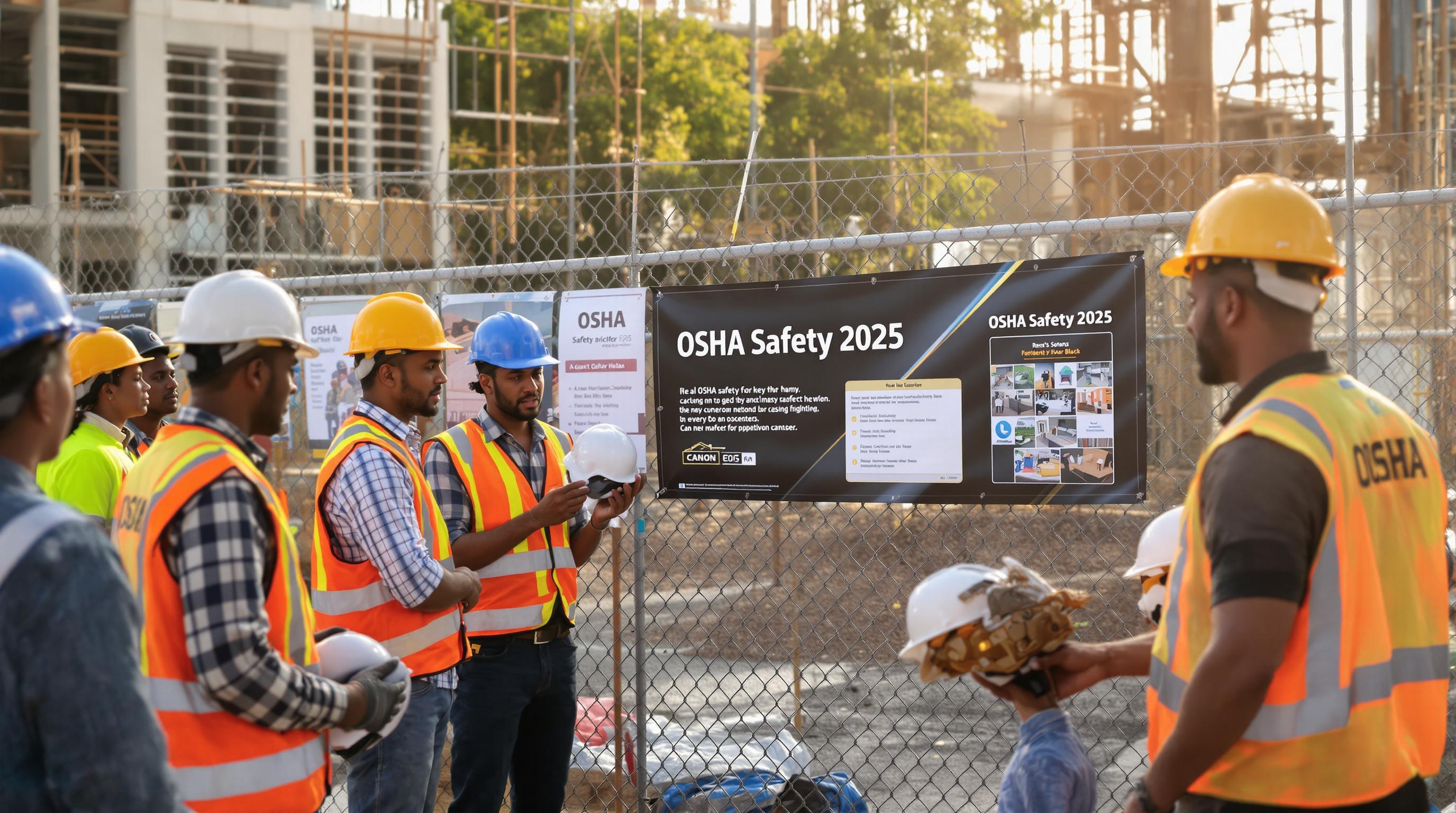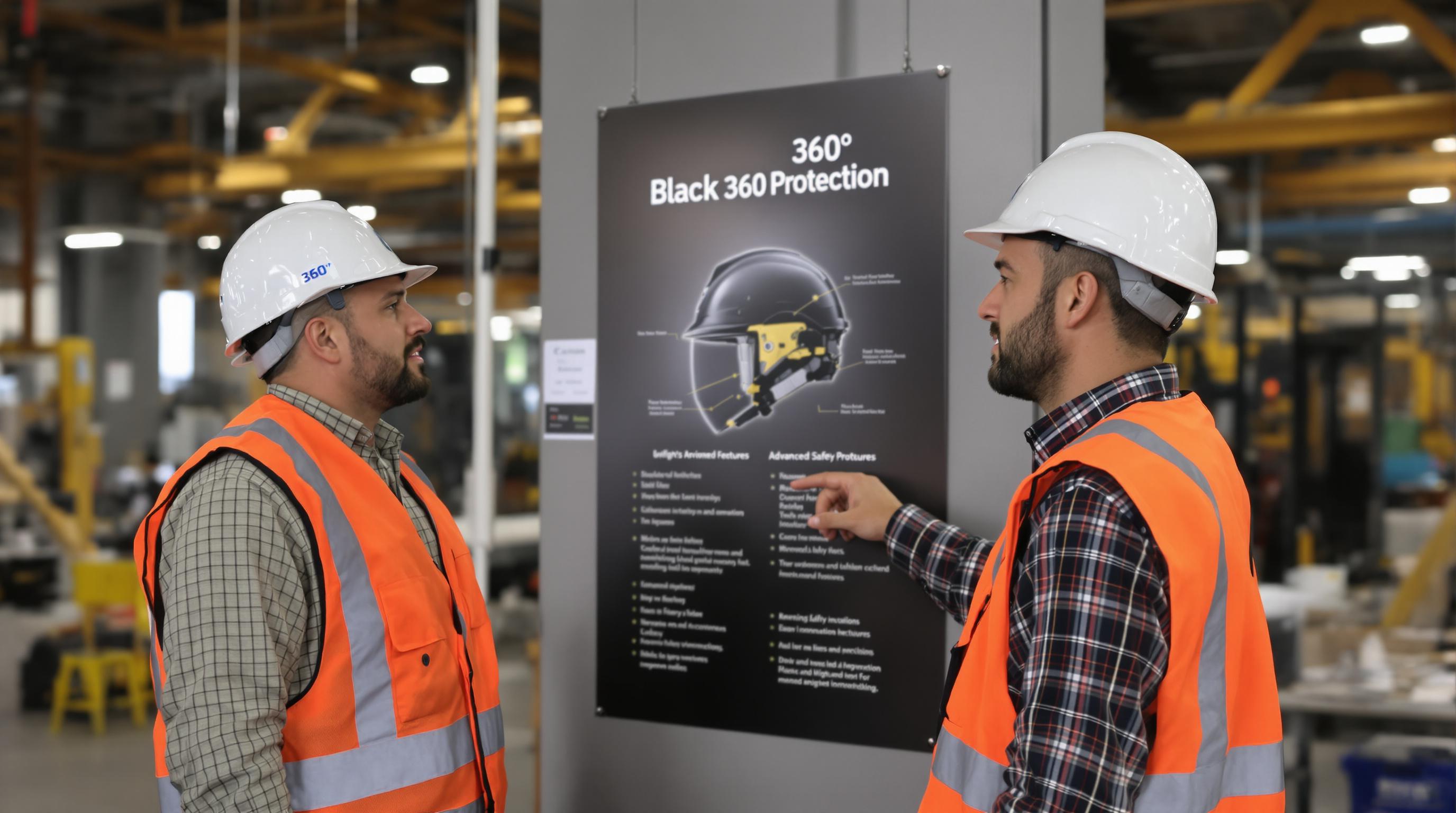OSHA is completely rewriting the rules on head protection in 2025. Forget everything you know about hard hats because employers now face stricter requirements and must transition to safety helmets offering 360-degree coverage and advanced impact resistance. Most people think a quick inspection and a check for cracks is enough, but the surprising truth is that even the best old-school hard hat may soon be out of compliance. There is a whole new set of standards and features that every workplace will need to follow—and it is more complex than ever.
Table of Contents
- Understanding OSHA Hard Hat Requirements 2025
- Key Differences: Hard Hats Vs Safety Helmets
- Choosing The Right Protection For Your Workplace
- Maintaining And Inspecting Hard Hats For Safety
Quick Summary
| Takeaway | Explanation |
|---|---|
| Transition to Safety Helmets | OSHA’s 2025 requirements emphasize the need for safety helmets over traditional hard hats, mandating full head coverage and integrated features for enhanced protection. |
| Comprehensive Workplace Hazard Assessment | Employers must conduct thorough assessments of workplace hazards, including potential falling objects and electrical risks, to ensure appropriate helmet selection. |
| Regular Inspection and Maintenance | Helmets require systematic inspections for integrity and damage, with immediate replacement after significant impact and proper care to extend their lifecycle. |
| Adherence to Standards and Protocols | Compliance with ANSI Z89.1 standards is critical in choosing helmets; proper fit and maintenance protocols are essential in ensuring optimal worker protection. |
Understanding OSHA Hard Hat Requirements 2025

OSHA hard hat requirements are evolving rapidly in 2025, reflecting significant advancements in workplace safety technology and protection standards. The regulatory landscape is shifting from traditional hard hats to more comprehensive safety helmets that offer enhanced protection for workers across multiple industries.
The Changing Definition of Head Protection
Traditional hard hats have long been the standard for workplace safety, but recent OSHA guidelines on protective equipment are transforming how employers think about head protection. According to the American Society of Safety Professionals, the new requirements focus on comprehensive protection that goes beyond simply covering the top of the head.
The 2025 OSHA requirements now mandate safety helmets that provide:
- Full Head Coverage: Protection from multiple impact angles
- Integrated Safety Features: Built-in options for face shields and hearing protection
- Advanced Impact Resistance: Materials that offer superior protection against workplace hazards
Critical Changes in Head Protection Standards
Workplace safety is no longer just about meeting minimum requirements. The 2025 OSHA hard hat requirements represent a significant leap forward in worker protection. According to OSHA’s December 2023 announcement, compliance safety, and health officers will now be required to wear modern safety helmets that provide more comprehensive protection compared to traditional hard hats.
Key changes include stricter requirements for:
- Impact resistance testing
- Side protection capabilities
- Chin strap requirements
- Material durability standards
These updates reflect a growing understanding that worker safety demands more than basic head coverage. Learn more about comprehensive safety equipment to understand how these new standards will impact workplace safety protocols.
The shift towards more advanced safety helmets is not just about compliance. It represents a fundamental reimagining of workplace protection. Employers must now consider helmets that offer 360-degree protection, integrating multiple safety features into a single piece of equipment. This approach recognizes that workplace hazards are complex and require equally sophisticated protective solutions.
For workers and employers alike, the 2025 OSHA hard hat requirements signal a new era of safety consciousness. No longer are basic protective measures sufficient. The future of workplace safety demands comprehensive, intelligent design that prioritizes worker protection in every possible scenario.
Key Differences: Hard Hats vs Safety Helmets
The evolution of workplace safety equipment has led to a significant transformation in head protection, with safety helmets emerging as a more advanced alternative to traditional hard hats. Understanding the key differences between these two types of protective gear is crucial for workers and employers seeking optimal workplace safety.
Design and Structural Innovations
Traditional hard hats have primarily focused on top-of-head protection, utilizing rigid materials like high-density polyethylene. In contrast, modern safety helmets represent a comprehensive approach to head protection. According to OSHA’s Safety and Health Information Bulletin, these new helmets incorporate advanced materials, including lightweight composites, thermoplastics, and fiberglass that provide superior impact resistance.
The fundamental design differences are striking. While hard hats offer basic overhead protection, safety helmets provide 360-degree protection, addressing critical safety gaps. Explore our comprehensive safety equipment guide to understand these innovative design improvements.
Advanced Safety Features
Safety helmets dramatically expand protection beyond traditional hard hat capabilities. According to the American Society of Safety Professionals, modern safety helmets now include:
- Integrated Chin Straps: Preventing helmet displacement during slips or falls
- Side Impact Protection: Addressing vulnerabilities in traditional hard hat designs
- Built-in Communication Systems: Enabling clear workplace communication
- Modular Attachment Points: Supporting additional protective accessories
Performance and Technological Advancement
The performance gap between hard hats and safety helmets is substantial. Where traditional hard hats provide minimal protection, safety helmets offer comprehensive safety solutions. The OSHA December 2023 announcement highlighted that modern safety helmets now include features like integrated face shields, hearing protection, and advanced impact resistance technologies.
These technological advancements represent more than incremental improvements. They signify a fundamental reimagining of workplace head protection. Safety helmets are designed to address complex workplace hazards, offering protection that extends far beyond the basic coverage of traditional hard hats.
Workers in high-risk environments such as construction, industrial manufacturing, and emergency services will benefit most from these advanced protective solutions. The shift from hard hats to safety helmets reflects a broader commitment to worker safety, prioritizing comprehensive protection over minimal compliance.
As workplace safety standards continue to evolve, safety helmets are becoming the new benchmark for head protection. They represent a proactive approach to preventing workplace injuries, demonstrating that modern safety equipment can be both technologically sophisticated and practical for everyday use.
To help visualize the differences, the following table compares traditional hard hats and modern safety helmets across key design and safety elements:
| Feature/Aspect | Traditional Hard Hat | Modern Safety Helmet |
|---|---|---|
| Head Coverage | Top only | 360-degree (full around) |
| Impact Resistance | Basic (top impacts) | Advanced (multi-angle impacts) |
| Side Protection | Limited | Integrated |
| Chin Strap | Rare/optional | Required/Integrated |
| Materials | High-density polyethylene | Composites, thermoplastics, fiberglass |
| Accessory Integration | Minimal | Face shield, hearing, and communication |
| Compliance Standard | Legacy OSHA, ANSI Z89.1 (older) | Updated OSHA/ANSI Z89.1 (2025) |
Choosing the Right Protection for Your Workplace
Selecting the appropriate head protection is a critical decision that directly impacts worker safety and regulatory compliance. The 2025 OSHA requirements demand a more strategic approach to choosing safety helmets that go beyond traditional protective gear.
Workplace Hazard Assessment
Before selecting a safety helmet, employers must conduct a comprehensive workplace hazard assessment. According to OSHA’s guidelines, the selection process involves identifying specific risks unique to each work environment. These risks can include:
- Falling Object Potential: Assessing the size and weight of potential projectiles
- Impact Exposure: Evaluating the likelihood of collisions or struck-by incidents
- Electrical Hazards: Determining electrical risk levels in the workspace
The complexity of this assessment requires careful analysis. Explore our comprehensive safety assessment guide to understand the nuanced approach to workplace protection.
Helmet Specification Standards
OSHA mandates strict compliance with ANSI Z89.1 standards for safety helmets. The European Agency for Safety and Health at Work emphasizes that proper helmet selection involves multiple critical factors:
- Material durability
- Impact resistance ratings
- Electrical insulation properties
- Comfort and adjustability
- Weight and ventilation
Proper fit is crucial. A safety helmet that does not fit correctly offers minimal protection, regardless of its advanced features. Employers must ensure that selected helmets can be adjusted to individual worker specifications, providing both security and comfort.
Maintenance and Replacement Protocols
Choosing the right protection extends beyond initial selection. The December 2023 OSHA guidelines highlight the importance of ongoing maintenance and timely replacement of safety helmets. Helmets are not indefinitely effective and require regular inspection for:
- Structural integrity
- Signs of damage
- Material degradation
- Compromised protective features
Workers should be trained to recognize when a safety helmet has reached the end of its protective lifecycle. Factors such as sun exposure, chemical interactions, and physical impacts can compromise a helmet’s protective capabilities faster than many realize.
The transition to advanced safety helmets represents more than a regulatory requirement. It demonstrates a commitment to worker safety that goes beyond minimum compliance. By carefully selecting, maintaining, and replacing protective equipment, employers create a culture of safety that protects their most valuable asset, their workers.
Ultimately, choosing the right workplace protection is a complex process that requires ongoing attention, education, and commitment. The 2025 OSHA requirements push organizations to think more comprehensively about head protection, viewing safety helmets not just as equipment, but as a critical component of workplace risk management.
To clarify key factors to consider when selecting, maintaining, and replacing safety helmets, the following table summarizes critical requirements and best practices:
| Step/Aspect | Key Requirements/Actions | Frequency/Timing |
|---|---|---|
| Hazard Assessment | Evaluate falling objects, impact, and electrical risks | Before initial selection |
| Compliance Check | Ensure ANSI Z89.1 (2025) and material durability standards are met | During specification |
| Fit and Comfort | Adjustable to the individual worker’s head, comfort, and ventilation | Upon issuance and adjustment |
| Regular Inspection | Check shell integrity, suspension system, and color changes | Before every use / monthly |
| Maintenance | Clean, store properly, avoid chemical/sun exposure | Ongoing |
| Replacement | Replace every 2-5 years or after significant impact or damage | As needed/after incidents |
| Training | Educate workers on inspection, reporting, and replacement protocols | New hire/annual |
Maintaining and Inspecting Hard Hats for Safety
Maintaining and inspecting safety helmets is a critical component of workplace safety that goes far beyond simple visual checks. The 2025 OSHA requirements emphasize comprehensive maintenance protocols that ensure protective equipment remains fully functional and capable of preventing potential head injuries.
Regular Inspection Protocols
According to the U.S. Forest Service safety guidelines, thorough hard hat inspections must be conducted systematically. Workers should examine both the shell and suspension system for signs of damage, including:
- Shell Integrity: Checking for cracks, dents, or structural compromises
- Color Changes: Identifying Potential Material Degradation
- Suspension System: Verifying the condition of internal support mechanisms
Learn more about comprehensive helmet maintenance to understand the intricate details of proper safety equipment care.
Replacement and Lifecycle Management
The Electronic Library of Construction Occupational Safety and Health provides clear guidelines on hard hat lifecycle management. Critical considerations include:
- Replacing hard hats every two to five years
- Immediate replacement after any significant impact
- Avoiding modifications that could compromise structural integrity
- Documenting inspection and replacement records
Environmental factors play a significant role in helmet degradation. Exposure to sunlight, extreme temperatures, and chemical interactions can accelerate material breakdown, potentially reducing protective capabilities.
Maintenance Best Practices
OSHA’s Field Safety and Health Management System Manual emphasizes proactive maintenance strategies. Workers must:
- Clean helmets regularly using manufacturer-recommended methods
- Store helmets in cool, dry environments away from direct sunlight
- Avoid storing helmets in locations with potential chemical exposure
- Report any signs of damage immediately to supervisors
The 2025 safety standards require more than passive maintenance. They demand an active approach where workers are trained to recognize potential equipment vulnerabilities and take immediate corrective action.
Beyond technical considerations, maintaining safety helmets represents a broader commitment to workplace safety. Each inspection is an opportunity to reinforce safety culture, demonstrating that protecting workers goes beyond mere compliance with regulations.
Ultimately, proper hard hat maintenance is a shared responsibility. Employers must provide training, resources, and clear protocols, while workers must remain vigilant and proactive in identifying and addressing potential equipment issues. This collaborative approach ensures that protective equipment remains a reliable safeguard against workplace hazards.
Frequently Asked Questions
What are the main changes to OSHA hard hat requirements in 2025?
The 2025 OSHA requirements emphasize the transition from traditional hard hats to safety helmets that offer 360-degree coverage, advanced impact resistance, and integrated safety features.
Why are safety helmets preferred over traditional hard hats?
Safety helmets provide comprehensive head protection, including side impact protection and integrated accessories like face shields and hearing protection, addressing the complexities of modern workplace hazards.
How often should safety helmets be inspected and replaced?
Safety helmets should be inspected regularly for cracks or damage, ideally before every use, and should be replaced every 2-5 years or immediately after significant impacts.
What is involved in a workplace hazard assessment related to head protection?
A workplace hazard assessment involves identifying specific risks such as falling objects, impact exposure, and electrical hazards to ensure the proper selection of safety helmets for the work environment.
Ready for OSHA’s 2025 Hard Hat Rules? Secure Real Protection Now
As you read about the upcoming OSHA safety helmet regulations, you might feel anxious about whether your team’s equipment is truly up to standard. The reality is that workplaces need to transition from old-fashioned hard hats to fully compliant safety helmets that deliver 360-degree coverage and advanced impact resistance. Outdated gear not only puts your crew at risk but could result in failing to meet strict new compliance standards and inspections. Your goal is safer workers, zero downtime, and real peace of mind.
Make the move toward full compliance today and avoid last-minute scrambling. Explore our expert selection of Hard Hats for Safety and discover industry-leading solutions explained in everyday language. For help choosing the right helmets or planning your upgrades, visit our website for answers and streamlined purchasing. Stay ahead of OSHA requirements to keep your workplace both safe and prepared.
Recommended
- How Long Are Hard Hats Good for OSHA
- Safety First: Stay Safe and Secure for Every Family!
- Safety First, Style Second: How to Wear a Hard Hat
- How to Wear a Hard Hat Properly for Maximum Safety
- Work at Height Hazards: Essential Insights for 2025 – Sterling Access
- Safety Training Requirements Employers Need to Know | 2025 Guide – Peuneo

